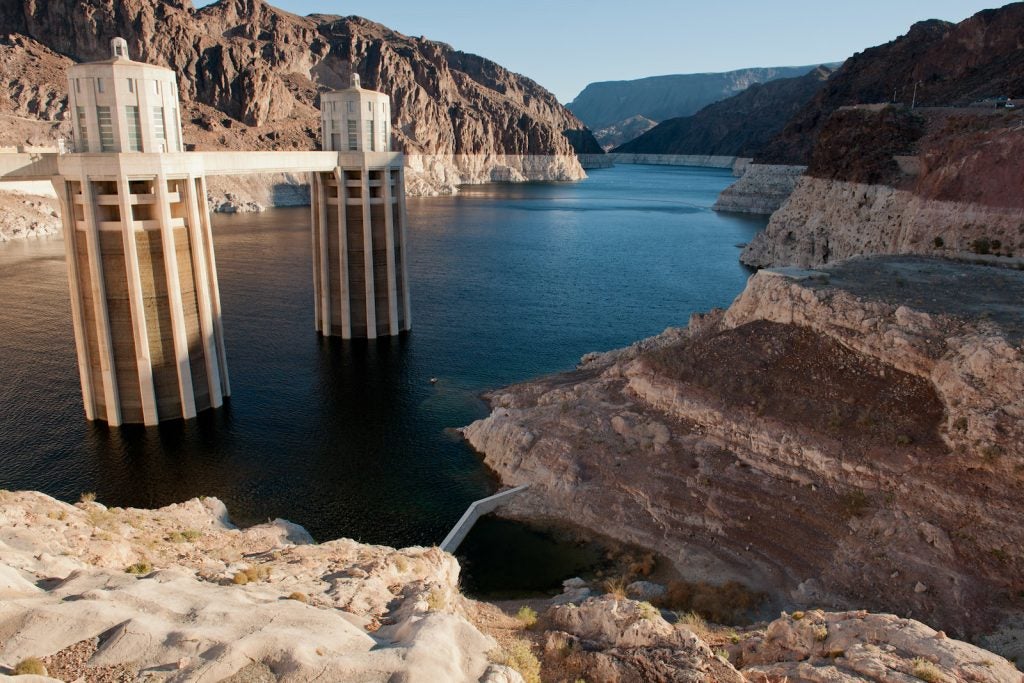Arizona just got another temporary reprieve from water cuts in Lake Mead, for the second year in a row. However, sustainable water management — of both the Colorado River and groundwater — remains crucial for communities in the Southwest to become resilient to increasingly arid conditions.
A new, closely watched 24-month study of water levels on Lake Mead, the country’s largest reservoir, means Arizona has managed to avoid substantial water cuts next year. On Thursday, the U.S. Bureau of Reclamation predicted Lake Mead’s elevation will be 1,089.4 feet on Jan. 1, thanks to an unusually wet winter and seven states reaching a historic agreement on how to conserve Colorado River water.
The forecast triggers what is called a “tier zero shortage” because it falls under a threshold of 1,090 feet, which means Arizona will have to reduce its share of Lake Mead water in 2020 by 192,000 acre-feet, roughly the amount used by 400,000 households in one year. If the forecast had predicted the lake would fall to less than 1,075 feet, as some feared before the wet winter, Arizona would have had to reduce its take of Lake Mead water by a much larger 512,000 acre-feet.
Arizona agreed to that higher cut as part of the Drought Contingency Plan, a deal by the seven Colorado River Basin states and Mexico to conserve Colorado River water in response to a nearly two-decade drought. Reaching an agreement in Arizona was particularly challenging because Central Arizona water users have junior water rights, subordinate to other Lower Basin water users, including California. The Arizona component of the agreement required tremendous collaboration and some trade-offs among tribes, farmers, cities, businesses and water agencies.
Four priorities for a water-secure future in Arizona
The Drought Contingency Plan doesn’t wash away Arizona’s water woes: Lake Mead is still less than half full. EDF and our partners in the Water for Arizona Coalition will remain laser focused on at least four major water issues going forward:
1. Sustainable groundwater management.
Groundwater supplies about 40% of Arizona’s annual water use and in many rural areas is the only source of water. Yet there are few tools in rural communities to support sustainable, locally driven water planning. We need to support the local communities that seek sound water management, as the Legislature has begun to do by enacting legislation to study groundwater in Mohave and La Paz counties.
2. Expand conservation programs.
Arizona must move beyond the mindset of getting “the next big bucket of water” from new and expensive water projects. Instead, we must double down our efforts on conserving the water we already have. Programs that support incentives for converting to lower water-use crops and access to new water-efficient technologies can help to continue conserving water while engaging diverse corporate, community and philanthropic partners.

Photo Credit: Bureau of Reclamation
3. Adequate funding.
The Arizona Department of Water Resources is a critical government agency responsible for managing water resources and facilitating fundamental scientific research and data gathering. However, during the Great Recession, the agency’s staff numbers fell from 230 employees and have not recovered. The Legislature agreed to raise the employee count to 145 in 2020. We should continue to increase funding to return to 2008 levels. We must harness the spirit of collaboration that led to adoption of the Drought Contingency Agreement to ensure sustainable water management also applies to groundwater, conservation and funding. Share on X
4. Balance supply and demand.
The Colorado River system has long faced one fundamental problem: Water use outstrips supply. This stems in part from hydrologists using some of the wettest years on record when they figured out how to distribute Colorado River water nearly a century ago. The Drought Contingency Plan takes an important step in addressing this unfortunate miscalculation, but it will expire in 2026.
Discussions are already starting on how to develop a process to create new guidelines by 2022. Those next guidelines will provide an important opportunity to address the long-term imbalance in supply and demand along the Colorado River.
Water is the lifeblood of Arizona’s economy, our communities and our spectacular environment. We are lucky a wet year delayed deeper water cuts from Lake Mead and should be proud of the Drought Contingency Plan. However, we can’t sit back and relax. In Arizona, we must harness the spirit of collaboration that led to adoption of the Drought Contingency Agreement to ensure sustainable water management also applies to groundwater, conservation and funding. Our future depends on it.










4 Comments
I know this sounds crazy today, but start planning a large water pipeline or two, from Alaska to the Colorado River, with outlets at various rivers and towns along the way who will be needing water. Build it big, build it smart, and build it slowly over time. Nobody would complain about a water spill from water pipelines.
As a water treatment expert I have studied issues on water use and conservation and used them as input for marketing strategies in water businesses. Living next to Great Lakes I was shocked to find that residential water costs are HIGHER in Chicagoland than in Phoenix.
Where’s the supply and demand principle?
How can you hope to survive if water is devalued in such a way?
How about reduction of watering lawns? Or increased education about water conservation? I haven’t seen a single commercial or billboard educating the metropolitan Phoenix area about the need to conserve. Wouldn’t this be the obvious first step?
Yeah, lets build more pools, and water parks!